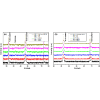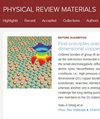Multi-mem behavior at reduced voltages in La1/2Sr1/2Mn1/2Co1/2O3−x perovskite modified with Sm:CeO2
IF 3.1
3区 材料科学
Q2 MATERIALS SCIENCE, MULTIDISCIPLINARY
引用次数: 0
Abstract
The use of machine learning algorithms is exponentially growing and concerns are being raised about their sustainability. Neuromorphic computing aims to mimic the architecture and the information processing mechanisms of the mammalian brain, appearing as the only avenue that offers significant energy savings compared to the standard digital computers. Memcapacitive devices, which can change their capacitance between different nonvolatile states upon the application of electrical stimulation, can significantly reduce the energy consumption of bio-inspired circuitry. In the present work, we study the multi-mem (memristive and memcapacitive) behavior of devices based on thin films of the topotactic redox (LSMCO) perovskite modified with Sm: (SCO), grown on Nb: with (001) and (110) out-of-plane orientations. Either the self-assembling at the nanoscale of both LSMCO and SCO phases or the doping with Ce(Sm) of the LSMCO perovskite were observed for different fabrication conditions and out-of-plane orientations. The impact of these changes on the device electrical behavior was determined. The optimum devices resulted those with (110) orientation and Ce(Sm) doping the perovskite. These devices displayed a multi-mem behavior with robust memcapacitance and significantly lower operation voltages (especially the reset voltage) in comparison with devices based on pristine LSMCO. In addition, they were able to endure electrical cycling—and the concomitant perovskite topotactic redox transition between oxidized and reduced phases—without suffering nanostructural changes nor cationic segregation. We link these properties to an enhanced perovskite reducibility upon Ce(Sm) doping. Our work contributes to increasing the reliability of LSMCO-based multi-mem systems and to reducing their operating voltages closer to the 1 V threshold, which are key issues for the development of nanodevices for neuromorphic or in-memory computing.

用 Sm:CeO2 修饰的 La1/2Sr1/2Mn1/2Co1/2O3-x 包晶在降低电压时的多存储器行为
机器学习算法的使用呈指数级增长,人们开始关注其可持续性。神经形态计算旨在模仿哺乳动物大脑的架构和信息处理机制,与标准数字计算机相比,它似乎是唯一能显著节约能源的途径。Memcapacitive 器件在施加电刺激时可在不同的非易失性状态之间改变电容,可显著降低生物启发电路的能耗。在本研究中,我们研究了基于用 Sm:CeO2 (SCO) 修饰的拓扑活性氧化还原 La1/2Sr1/2Mn1/2Co1/2O3-x (LSMCO) 包晶石薄膜的器件的多存储器(memristive 和 memcapacitive)行为,该薄膜生长在具有 (001) 和 (110) 面外取向的 Nb:SrTiO3 上。在不同的制造条件和面外取向下,观察到了 LSMCO 和 SCO 相在纳米尺度上的自组装,或 LSMCO 包晶体中的 Ce(Sm)掺杂。确定了这些变化对器件电气行为的影响。最佳器件是那些具有 (110) 方向和掺杂了 Ce(Sm) 的过氧化物。与基于原始 LSMCO 的器件相比,这些器件显示出具有强大记忆电容和显著较低工作电压(尤其是复位电压)的多记忆行为。此外,这些器件还能承受电循环以及氧化相和还原相之间的包晶拓扑氧化还原转变,而不会发生纳米结构变化或阳离子偏析。我们将这些特性与掺杂 Ce(Sm)后增强的包晶还原性联系起来。我们的工作有助于提高基于 LSMCO 的多内存系统的可靠性,并将其工作电压降至接近 1 V 的阈值,这是开发用于神经形态或内存计算的纳米器件的关键问题。
本文章由计算机程序翻译,如有差异,请以英文原文为准。
求助全文
约1分钟内获得全文
求助全文
来源期刊

Physical Review Materials
Physics and Astronomy-Physics and Astronomy (miscellaneous)
CiteScore
5.80
自引率
5.90%
发文量
611
期刊介绍:
Physical Review Materials is a new broad-scope international journal for the multidisciplinary community engaged in research on materials. It is intended to fill a gap in the family of existing Physical Review journals that publish materials research. This field has grown rapidly in recent years and is increasingly being carried out in a way that transcends conventional subject boundaries. The journal was created to provide a common publication and reference source to the expanding community of physicists, materials scientists, chemists, engineers, and researchers in related disciplines that carry out high-quality original research in materials. It will share the same commitment to the high quality expected of all APS publications.
 求助内容:
求助内容: 应助结果提醒方式:
应助结果提醒方式:


